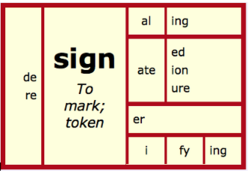Philosophy:Structured word inquiry
Structured Word Inquiry (SWI) is a pedagogical technique involving the scientific investigation of the spelling of words.[1][2][3] SWI considers morphology,[4][5] etymology, relatives, and phonology.[3][6] The guiding principles of SWI are (1) "the primary function of English spelling is to represent meaning"[7] and (2) "conventions by which English spelling represents meaning are so well-ordered and reliable that spelling can be investigated and understood through scientific inquiry."[6][8][9]
Four questions
SWI uses four questions to investigate the spelling of a word:[6][10]
- What is the meaning of a word?
- What are the morphemes of the word?
- What are morphological and etymological relatives of the word?
- What are the letters doing in the word (spelling phonemes, functioning as markers, zeroed)?
The questions must be investigated in order starting with the meaning.
Word sums
A word sum shows how a word is built.[10][11] A word sum is a "necessary tool to allow falsification of hypotheses of orthographic morphological structure."[3][6]
The following are examples of word sums:
- de + sign -> design
- de + sign + ate + ed-> designated
- sign + al -> signal
- sign + ate + ure -> signature
- re + sign + ate + ion -> resignation
Word Matrices
A word matrix is a visualization of the morphology of related words.[10][6][11]
References
- ↑ Bowers, Peter (11 November 2019). Teaching How the Written Word Works. https://linguisteducatorexchange.com/product/teaching-how-the-written-word-works-by-peter-bowers/.
- ↑ Cooke, Gina (22 April 2019). "OG, SWI, and Other Acronyms". https://linguisteducatorexchange.com/2019/04/22/og-swi-and-other-acronyms/. Retrieved 19 July 2020.
- ↑ Jump up to: 3.0 3.1 3.2 "What Is Structured Word Inquiry?". https://www.nuevaschool.org/student-experience/lower-school/structured-word-inquiry. Retrieved 19 July 2020.
- ↑ Bowers, Peter N.; Kirby, John R.; Deacon, S. Hélène (June 1, 2010). "The Effects of Morphological Instruction on Literacy Skills: A Systematic Review of the Literature". Review of Educational Research 80 (2): 144–179. doi:10.3102/0034654309359353. https://journals.sagepub.com/doi/abs/10.3102/0034654309359353.
- ↑ Bowers, Peter N.; Cooke, Gina. "Morphology and the Common Core Building Students' Understanding of the Written Word". http://files.realspellers.org/PetesFolder/Articles/Bowers_Cooke_Morphology.pdf. Retrieved 19 July 2020.
- ↑ Jump up to: 6.0 6.1 6.2 6.3 6.4 Bowers, Susan; Bowers, Peter. "Understanding SWI: "Structured Word Inquiry" or "Scientific Word Investigation"". http://www.wordworkskingston.com/WordWorks/Structured_Word_Inquiry.html. Retrieved 19 July 2020.
- ↑ Martin, Nancy. "Struct +ure/ +ed Word + Inquire/ +y (SWI)". https://www.eaglehill.school/blog-detail?pk=1008878. Retrieved 21 July 2020.
- ↑ "Structured Word Inquiry". https://sites.google.com/view/thereadingandlearningclinicofm/evidence-based-and-effective-approaches/structured-word-inquiry. Retrieved 19 July 2020.
- ↑ Bowers, Jeffrey S.; Bowers, Peter N.. "The importance of correctly characterising the English spelling system when devising and evaluating methods of reading instruction: Comment on Taylor, Davis, and Rastle". http://files.realspellers.org/PetesFolder/Articles/bowersa_bowers_commentary_2018.pdf.
- ↑ Jump up to: 10.0 10.1 10.2 Kosur, Heather Marie. "Structured Word Inquiry". https://teachastudenttoread.com/swi/. Retrieved 19 July 2020.
- ↑ Jump up to: 11.0 11.1 Ramsden, Neil. "Mini Matrix-Maker Home Page". http://www.neilramsden.co.uk/spelling/matrix/index.html. Retrieved 19 July 2020.
 |


